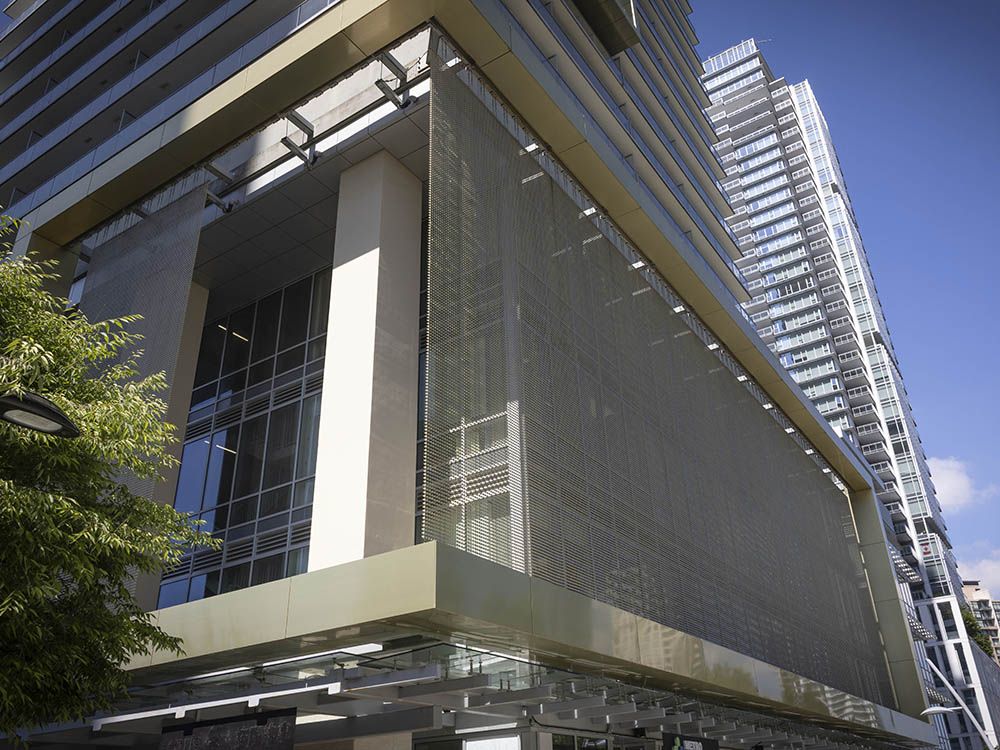
When a developer got the green light for a mixed-use development near Metrotown that went up in 2020, it was on the condition that it contribute an innovative piece of public art: a giant, three-storey LED wall that would display art in a collaboration with the Burnaby Art Gallery.
But because of a dispute between the building’s strata and two commercial owners whose units were used for the screen’s power supply, it has remained dark. That could finally be changing.
In a recent B.C. Supreme Court ruling , the strata won the right to reinstall the transformers in the units to power the $1 million digital screen across three storeys of the tower — celebrated at the time as the largest non-commercial urban art LED display in North America.
Both owners were unaware that the power supply was in the ceilings of their units before they bought them from the developer, Rize Alliance Properties Ltd. One, Hope Health Holdings Ltd., removed the transformers soon after buying a unit in June 2020. The other unit’s transformers were removed by the original tenants before a numbered company bought it in January 2022.
The City of Burnaby threatened to sue if the screen remains dark much longer, and made submissions in court as an outside party.
The strata for the mixed residential-commercial building at McKay Avenue and Beresford Street, known as Gold House — North Tower, claimed both owners breached its bylaws by refusing to allow it to enter the units and put the billboard’s power supply back in place. It argued the transformers, 21 in the Hope Health unit and 51 in the numbered company’s unit, were common property and that it has a right to gain access to the units to repair, maintain or replace them.
“The strata says it brought this petition because the city has threatened legal action against the strata if the digital screen is not operational soon,” said the ruling posted online late last week.

The city told the strata in February 2023 that it and the owners of the two units were in non-compliance with the public art covenant and encouraged the strata to “obtain access, voluntarily or otherwise, to Units 403 and 405” to complete corrective work proposed by the developer.
Developer Rize Alliance, which wasn’t a party to the court petition, didn’t tell either owner that transformers were installed in their units instead of in common areas of the building.
Hope Health and the numbered company “say the developer ought to have installed the transformers on common property rather than within their strata units,” but that wasn’t a factor in the court case and Judge Julianne Lamb said that issue will have to be dealt with separately.
The owners also said the transformers as originally installed may not be safe — again, an issue for another day, said the judge. Whether the public art covenant is valid and enforceable is similarly not a part of the ruling.
The covenant was signed in late 2019 between Rize Alliance and the City of Burnaby as part of the rezoning of the property, and required that the developer include a public art feature that met the city’s approval. It said the developer would maintain, clean and repair the public art and wouldn’t remove it unless it was damaged beyond repair, in which case the developer would have to replace it with something similar.
The covenant is registered against the strata and unit owners, but “there is no evidence that the respondents formally agreed to assume the developer’s obligations under the public art covenant.”
The presale contract only informed buyers that “certain public art, with illumination and/or movable parts, may be located on the common property of the development adjacent to the strata lot,” and warned the art “may obstruct sight lines or light, and that noise, light or vibrations from the public art may be perceptible by the occupants of the strata lot.” It made no mention of components for the screen being in either of the units.
The strata argued Hope Health’s removal of the transformers breached its bylaws, which include a provision that no owner or occupant is allowed to “alter his or her strata lot, in any manner, which in the opinion of the strata council will alter the exterior appearance of the building or adversely interfere with the visibility, appearance, operation, repair or maintenance of the digital screen.”
Because the transformers were removed by a former owner of its unit, the strata doesn’t allege a bylaw breach by the numbered company. But its refusal to allow entry to the unit after notice was given was a breach, the strata argued.
The alleged bylaw breach by Hope Health when it removed the transformers in 2020 wasn’t accepted, because the judge said the strata took too long to give notice and the limitation period had expired.
However, the strata is entitled to replace the transformers because they are needed so residents, unit owners and the public can enjoy the “common property” of a working digital screen on the face of the building.
The judge decided a mandatory injunction allowing the strata’s contractors to enter the units is warranted, but said the strata isn’t entitled to make either unit owner pay for the work.
Postmedia News has reached out to the City of Burnaby to find out what happens next with the public art display.